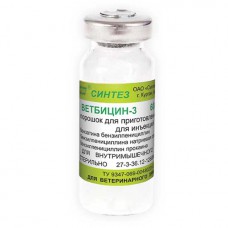Expiration date: 01/2026
Vetbicin-3 is a long-acting medicinal antibacterial agent in the form of a powder for the preparation of an injectable solution. It is a white or white powder with a yellowish tinge of color, with water it forms a stable suspension.
STRUCTURE
As active ingredients, it contains a mixture of three antibiotics: benzatin benzylpenicillin, benzylpenicillin sodium (or potassium) salt and benzylpenicillin novocaine salt.
PHARMACOLOGICAL PROPERTIES
Vetbicin-3-a complex antibacterial agent containing three biosynthetic penicillins, has a wide spectrum of antibacterial action against most Gram-positive and some Gram-negative microorganisms, including streptococci, staphylococci, pneumococci, diplococci, spirochetes, anthrax bacillus, corynebacteria; does not act on anaerobic bacteria, mycobacteria, fungi, viruses and rickettsias. The mechanism of the bactericidal action of penicillins is based on the violation of the synthesis of peptidoglycan (mucopeptide), which is part of the cell wall of microorganisms, by inhibiting the enzymes transpeptidase and carboxypeptidase, which leads to a violation of the osmotic balance and destruction of the bacterial cell. After intramuscular administration, Vetbicin-3 is absorbed into the blood, slowly hydrolyzed with the release of benzylpenicillin, reaching a maximum concentration after 12 to 24 hours, and remains in therapeutic concentration for 3 to 4 days. It is excreted mainly in the urine and partly in the feces. Vetbicin-3 according to the degree of exposure to the body of warm-blooded animals belongs to the 2nd class of danger (highly toxic substances).
INDICATIONS
Vetbicin-3 is prescribed to large and small cattle, horses, pigs, fur-bearing animals, rabbits, turkeys, geese and ducks for the treatment of pasteurellosis, bronchopneumonia, diseases of the genitourinary system, anthrax, necrobacteriosis, streptococcosis, actinomycosis, emphysematous carbuncle, wound and postpartum sepsis, as well as other primary and secondary infections caused by sensitive to antibiotics of the penicillin series with pathogens.
DOSAGE AND METHOD OF ADMINISTRATION
Before use, 5-6 ml of water for injection (or a sterile isotonic solution of sodium chloride, or 1 – 2% sterile solution of novocaine) is added to the bottle with Vetbicin – 3, puncturing the cap and stopper, and the bottle is thoroughly shaken until a homogeneous suspension is formed, which is immediately administered to the animal deeply intramuscularly. If the needle gets into the vessel and a drop of blood appears, the needle must be removed and the injection must be repeated in another place. The resulting suspension is administered to animals once in the following single doses:
Cattle 10,000 -15,000 units /kg of animal weight
Horses 10 000-15 000 units /kg of animal weight
Small cattle 15 000-20 000 units /kg of animal weight
Pigs 10 000-20 000 units /kg of animal weight
Fur-bearing animals 50 000-60 000 units/ animal
Rabbits 10 000-15 000 units/ animal
Turkeys, geese, ducks 100 000 units /kg of animal weight
If necessary, Vetbicin-3 is reused after 3 to 4 days.
SIDE EFFECTS
Hypersensitive animals may have allergic reactions. With increased individual sensitivity of the animal to penicillin-type antibiotics and the appearance of allergic reactions, the use of the drug is discontinued and desensitizing therapy is performed.
CONTRAINDICATIONS
Increased individual sensitivity to the components of the drug.
SPECIAL INSTRUCTIONS
Slaughter of animals for meat is allowed 14 days after the last application of Vetbicin-3. The meat of animals forcibly killed before the expiration of the specified period can be used for feeding carnivorous animals or for processing into meat-bone meal. Milk from dairy animals obtained during the treatment period and within 7 days after the last administration of Vetbicin-3 is forbidden to be used for food purposes. Such milk can be used after heat treatment for feeding animals.
SHELF LIFE AND STORAGE
Store with List B caution. In a dry place, protected from direct sunlight and out of the reach of children and animals, at a temperature of 0 to 25 °C. Shelf life — 3 years.
PACKAGING
They are produced packaged in 600,000 units in hermetically sealed glass bottles with a capacity of 10 ml, capped with rubber stoppers and rolled with aluminum caps.



